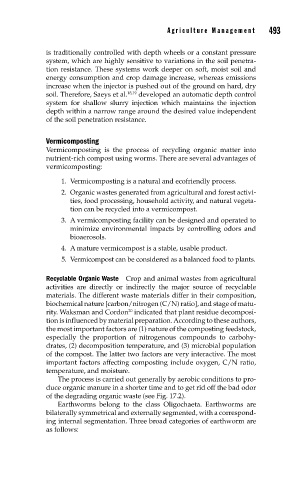Page 521 - Biosystems Engineering
P. 521
Agricultur e Management 493
is traditionally controlled with depth wheels or a constant pressure
system, which are highly sensitive to variations in the soil penetra-
tion resistance. These systems work deeper on soft, moist soil and
energy consumption and crop damage increase, whereas emissions
increase when the injector is pushed out of the ground on hard, dry
soil. Therefore, Saeys et al. 18,19 developed an automatic depth control
system for shallow slurry injection which maintains the injection
depth within a narrow range around the desired value independent
of the soil penetration resistance.
Vermicomposting
Vermicomposting is the process of recycling organic matter into
nutrient-rich compost using worms. There are several advantages of
vermicomposting:
1. Vermicomposting is a natural and ecofriendly process.
2. Organic wastes generated from agricultural and forest activi-
ties, food processing, household activity, and natural vegeta-
tion can be recycled into a vermicompost.
3. A vermicomposting facility can be designed and operated to
minimize environmental impacts by controlling odors and
bioaerosols.
4. A mature vermicompost is a stable, usable product.
5. Vermicompost can be considered as a balanced food to plants.
Recyclable Organic Waste Crop and animal wastes from agricultural
activities are directly or indirectly the major source of recyclable
materials. The different waste materials differ in their composition,
biochemical nature [carbon/nitrogen (C/N) ratio], and stage of matu-
rity. Waksman and Cordon indicated that plant residue decomposi-
20
tion is influenced by material preparation. According to these authors,
the most important factors are (1) nature of the composting feedstock,
especially the proportion of nitrogenous compounds to carbohy-
drates, (2) decomposition temperature, and (3) microbial population
of the compost. The latter two factors are very interactive. The most
important factors affecting composting include oxygen, C/N ratio,
temperature, and moisture.
The process is carried out generally by aerobic conditions to pro-
duce organic manure in a shorter time and to get rid off the bad odor
of the degrading organic waste (see Fig. 17.2).
Earthworms belong to the class Oligochaeta. Earthworms are
bilaterally symmetrical and externally segmented, with a correspond-
ing internal segmentation. Three broad categories of earthworm are
as follows:

